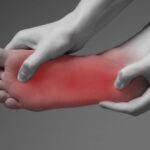Sports Medicine
Common Knee Injuries in Sports
The knee is one of the hardest-working joints in the human body. It allows us to run, jump, pivot, and perform countless daily activities. This joint plays an especially critical role in enhancing movement and agility for athletes. However, given its unique structure and frequent use, the knee is vulnerable to various injuries that can…
Read MoreSuffering from Jumper’s Knee? Try These 5 Patellar Tendonitis Exercises
Patellar tendonitis, or “jumper’s knee,” is caused by micro-tears on the patellar tendon, which connects your kneecap to your shinbone. It is a common knee injury in sports involving jumping and running, like basketball and volleyball. This injury can cause significant pain and soreness, limiting your ability to train, exercise, and carry out daily activities.…
Read MoreGolfer’s Elbow Treatment: What You Need to Know
Keeping your joints healthy is vital to staying active and mobile throughout your lifespan. Whether it’s your shoulder, knee, or elbow, a joint injury can be a frustrating and painful detour from your regular sports and exercise routines. Read on to learn about golfer’s elbow, a common sports injury that causes pain in the inner…
Read MoreThe Role of Physical Therapy in Sports Medicine
While many people come to sports medicine and physical therapy (PT) via injury, you can actually gain a lot of benefits from sports physical therapy to keep you strong and prevent future injuries, whether on the field, in the workplace, or playing with the kids in the backyard. Sports physical therapy isn’t just for athletes,…
Read MoreWhat Are the Long-Term Effects of a Crush Injury on the Foot?
Foot crush injuries can vary in severity but can often lead to long term debilitation and decreased quality of life. People that have suffered crush injuries of the foot often complain of stiffness, soreness, or inability to perform activities after an extended period of time. These injuries can also cause “dysesthesias” or abnormal sensations which…
Read MoreWhat Is a Fallen Arch and How Is It Treated?
Flat feet, or pes planus, can be a painful condition found in children whose arches don’t develop or in adults who have suffered from an injury. Fallen arches occur when the entire sole of the foot touches the floor when standing. Though some people may have the appearance of flat feet with no symptoms, others…
Read MoreRegenerative Orthopedics and Sports Medicine: A Natural Fit
Regenerative Orthopedics and Sports Medicine Dealing with the consequences of Injuries, aging, and everyday wear and tear is an inevitable part of life for athletes and active individuals. Fortunately sports medicine helps people recover from conditions that affect their mobility and range of movement. This blog focuses on a new type of sports medicine that…
Read MoreCommon Hip Injuries in Sports
The hip joint is a remarkable and intricate structure that plays a pivotal role in our body’s mobility and stability. The junction of the thigh bone (femur) and the pelvis, the hip joint enables a wide range of movements, from walking and running to sitting and bending. However, like any complex joint, the hip is…
Read MorePreparing for a Return to Play
Returning to Play After a sports injury, it’s common for people – particularly young athletes – to want to return to play as fast as they can. But it’s important to make sure that the body has a chance to rest and fully recover after an injury, particularly a torn ACL, a break or severe…
Read MoreJammed vs. Broken Finger: How Can I Tell?
A jammed finger is an incredibly common injury, especially if you play sports. While jammed fingers may be common, they can also be extremely painful and may require medical attention. Below, you can learn how to tell if you have a jammed finger or if the injury might be more severe. X-rays are essential in…
Read More









